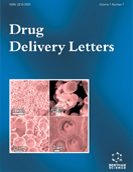Abstract
Background: The objective of this study was to develop liposomal mucoadhesive drug delivery system for the delivery of curcumin via nasal route, to avoid hepatic first pass metabolism, to increase residence time and to investigate its nose to brain delivery potential.
Methodology: The liposomes were prepared by solvent dispersion method using soya lecithin and cholesterol as a lipid phase and xanthan gum as a mucoadhesive polymer. The liposomes were evaluated for particle size, entrapment efficiency, mucoadhesion, DSC, ex vivo permeation, histopathological study, in vitro drug release, and in vivo study for the estimation of drug in brain after intranasal administration.
Results and Discussion: The particle size was in the range of 100.2-150 nm with good stability and controlled release characteristics without any deleterious effect on nasal mucosa of rat. When administered via intranasal route the liposomes showed higher drug distribution in brain (1240 ng) compared to drug solution (65 ng).
Conclusion: The results of the in vivo study suggests that the xanthan gum coated curcumin liposomes is a promising drug delivery system to deliver drug to the brain through nasal route.
Keywords: Curcumin, liposomes, mucoadhesion, nose to brain delivery, solvent dispersion method, xanthan gum.
Drug Delivery Letters
Title:Xanthan Gum Coated Mucoadhesive Liposomes for Efficient Nose to Brain Delivery of Curcumin
Volume: 5 Issue: 3
Author(s): Subodhkant Samudre, Avinash Tekade, Kanchan Thorve, Anup Jamodkar, Gauri Parashar and Nilima Chaudhari
Affiliation:
Keywords: Curcumin, liposomes, mucoadhesion, nose to brain delivery, solvent dispersion method, xanthan gum.
Abstract: Background: The objective of this study was to develop liposomal mucoadhesive drug delivery system for the delivery of curcumin via nasal route, to avoid hepatic first pass metabolism, to increase residence time and to investigate its nose to brain delivery potential.
Methodology: The liposomes were prepared by solvent dispersion method using soya lecithin and cholesterol as a lipid phase and xanthan gum as a mucoadhesive polymer. The liposomes were evaluated for particle size, entrapment efficiency, mucoadhesion, DSC, ex vivo permeation, histopathological study, in vitro drug release, and in vivo study for the estimation of drug in brain after intranasal administration.
Results and Discussion: The particle size was in the range of 100.2-150 nm with good stability and controlled release characteristics without any deleterious effect on nasal mucosa of rat. When administered via intranasal route the liposomes showed higher drug distribution in brain (1240 ng) compared to drug solution (65 ng).
Conclusion: The results of the in vivo study suggests that the xanthan gum coated curcumin liposomes is a promising drug delivery system to deliver drug to the brain through nasal route.
Export Options
About this article
Cite this article as:
Samudre Subodhkant, Tekade Avinash, Thorve Kanchan, Jamodkar Anup, Parashar Gauri and Chaudhari Nilima, Xanthan Gum Coated Mucoadhesive Liposomes for Efficient Nose to Brain Delivery of Curcumin, Drug Delivery Letters 2015; 5 (3) . https://dx.doi.org/10.2174/2210303106666160120215857
| DOI https://dx.doi.org/10.2174/2210303106666160120215857 |
Print ISSN 2210-3031 |
| Publisher Name Bentham Science Publisher |
Online ISSN 2210-304X |
 28
28
- Author Guidelines
- Bentham Author Support Services (BASS)
- Graphical Abstracts
- Fabricating and Stating False Information
- Research Misconduct
- Post Publication Discussions and Corrections
- Publishing Ethics and Rectitude
- Increase Visibility of Your Article
- Archiving Policies
- Peer Review Workflow
- Order Your Article Before Print
- Promote Your Article
- Manuscript Transfer Facility
- Editorial Policies
- Allegations from Whistleblowers
Related Articles
-
Glycogen Synthase Kinase-3 (GSK3) in Psychiatric Diseases and Therapeutic Interventions
Current Drug Targets P2Y Receptor Activation Affects the Proliferation and Differentiation of Glial and Neuronal Cells: A Focus on Rat C6 Glioma Cells
Current Neuropharmacology In Vitro Anticancer Effects of Two New Potent Hydrazide Compounds on Leukemic Cells
Anti-Cancer Agents in Medicinal Chemistry Novel Agents Targeting Crucial Signalling Pathways in Head and Neck Squamous Cell Carcinoma, HNSCC - Preclinical Development and Data from Clinical Trials
Current Proteomics Establishment of Cholinergic Neuron-like Cell Lines with Differential Vulnerability to Nitrosative Stress
Current Neurovascular Research Histone Deacetylase Inhibitors: Molecular and Biological Activity as a Premise to Clinical Application
Current Drug Metabolism Na<sup>+</sup>/K<sup>+</sup> ATPase Inhibitors in Cancer
Current Drug Targets Synthetic Lethality to Overcome Cancer Drug Resistance
Current Medicinal Chemistry Epigenetics in Cystic Fibrosis: Epigenetic Targeting of a Genetic Disease
Current Drug Targets Opiate Drug Use and the Pathophysiology of NeuroAIDS
Current HIV Research The Ubiquitin-Proteasome System and Proteasome Inhibitors in Central Nervous System Diseases
Cardiovascular & Hematological Disorders-Drug Targets Diagnosis, Pathogenesis and Therapeutic Targets in Amyotrophic Lateral Sclerosis
CNS & Neurological Disorders - Drug Targets Anticancer Antioxidant Regulatory Functions of Phytochemicals
Current Medicinal Chemistry Selective Acetyl- and Butyrylcholinesterase Inhibitors Reduce Amyloid-β Ex Vivo Activation of Peripheral Chemo-cytokines From Alzheimer's Disease Subjects: Exploring the Cholinergic Anti-inflammatory Pathway
Current Alzheimer Research Thrombospondin and Apoptosis: Molecular Mechanisms and Use for Design of Complementation Treatments
Current Drug Targets The Exploitation of Toll-like Receptor 3 Signaling in Cancer Therapy
Current Pharmaceutical Design Biosafety of Onco-Retroviral Vectors
Current Gene Therapy Novel Drug Therapies for Fertility Preservation in Men Undergoing Chemotherapy: Clinical Relevance of Protector Agents
Current Medicinal Chemistry The Role of the Metabolism of Anticancer Drugs in Their Induced-Cardiotoxicity
Current Drug Metabolism Proteasome Inhibitors Therapeutic Strategies for Cancer
Recent Patents on Anti-Cancer Drug Discovery


























